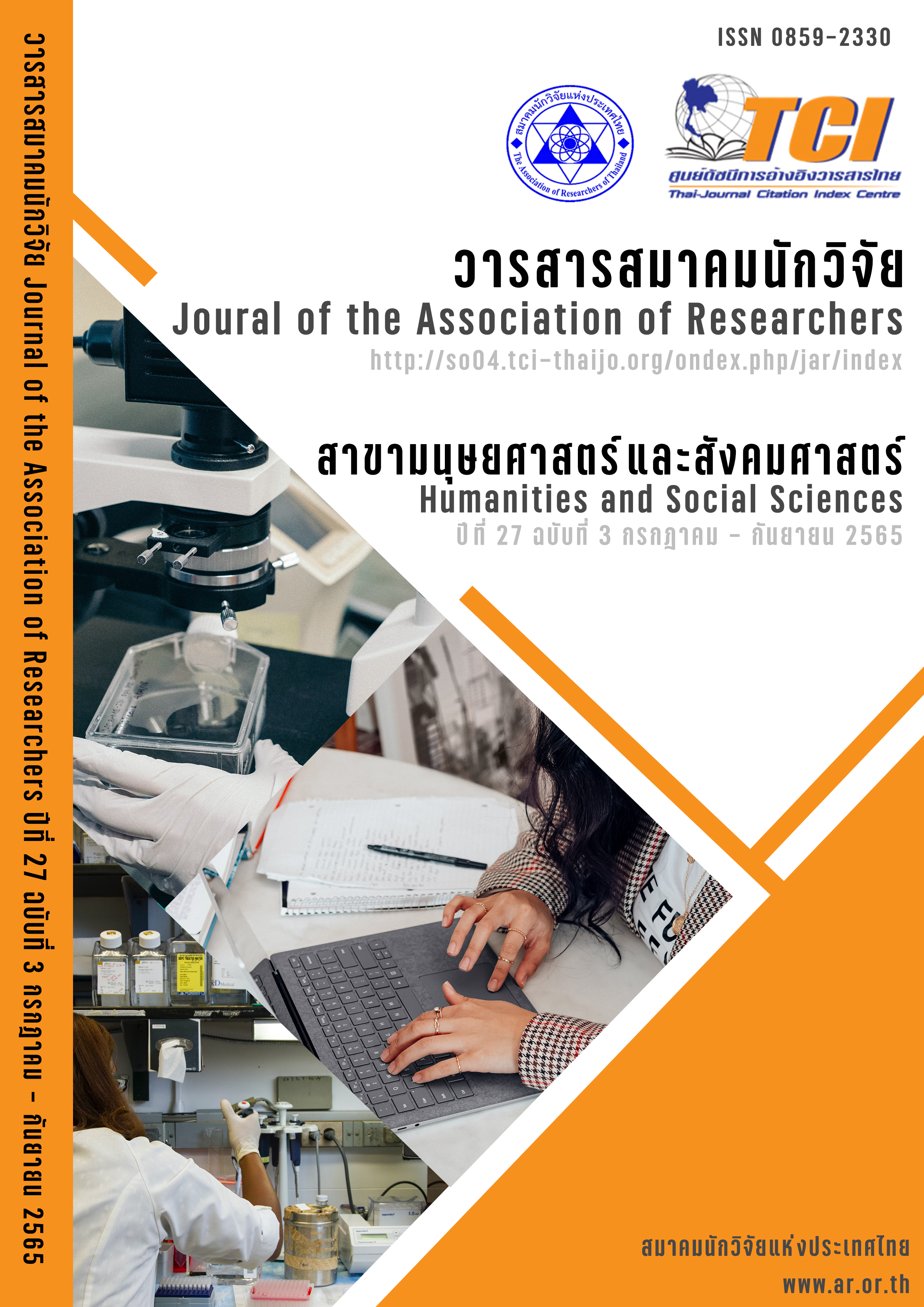The Relationship Between Organizational Resources and Warehousing Management in Modern Retail Business
Main Article Content
Abstract
The research studied the relationship between organizational resources and warehousing management in the modern retail business. This study aimed to investigate the factors toward the relationship between organizational resources and warehousing management in the modern retail business. This research was survey research of nonprobability samples of 420 respondents who were employed in the organizations such as managers, assistant managers, and staff members. Data was collected by using a questionnaire and analyzed by descriptive with inferential statistics and the structural equation model (SEM). The result was showed that the most of personnel were male between 21-25 years old single education senior high school and vocational certificate employing in a company with the experienced 1-5 years. According to the overall organization resources sampling groups were a high level of opinion as a whole (x̄= 4.04). First, the organization has introduced new technologies to be adapted to help the operation be faster and up to date (x̄= 4.16). The organization management was in accordance with the hierarchy of commanding (x̄=4.15). The overall satisfaction of the sampling groups was a high level of opinion as a whole (x̄= 4.13). Firstly, the expectation that the quickly servicing was meet the needs of customers (x̄= 4.25). Customers feel good about the convenience and service from the seller with speed and agility (x̄= 4.24). The overall management of the sampling groups was a high level of opinion as a whole (x̄=4.17). Firstly, the organization had a constant and consistent rate of product turnover (x̄=4.30) The organization was able to manage the total cost reduction from the best use of organizational resources in personnel, capital, materials, equipment, and technology (x̄= 4.19). And the findings were revealed that the factors of organizational resources were significantly directly (Path Coefficient=0.417*; DE=0.417*) that was related to the warehousing management in modern retail business and indirectly via satisfaction (Path Coefficient=0.299*; IE=0.299)
Article Details

This work is licensed under a Creative Commons Attribution-NonCommercial-NoDerivatives 4.0 International License.
บทความที่ปรากฏในวารสารนี้ เป็นความรับผิดชอบของผู้เขียน ซึ่งสมาคมนักวิจัยไม่จำเป็นต้องเห็นด้วยเสมอไป การนำเสนอผลงานวิจัยและบทความในวารสารนี้ไปเผยแพร่สามารถกระทำได้ โดยระบุแหล่งอ้างอิงจาก "วารสารสมาคมนักวิจัย"
References
ธานินทร์ ศิลป์จารุ. (2555). การวิจัยและการวิเคราะห์ข้อมูลทางสถิติด้วย SPSS และAMOS. พิมพ์ครั้งที่13 กรุงเทพฯ: อาร์แอนด์ดี หจก.
บุญชม ศรีสะอาด. (2535). การวิจัยเบื้องต้น. พิมพ์ครั้งที่ 2. กรุงเทพฯ: สุวิริยาสาส์น.
ปรีชา หงษ์ไกรเลิศ. (2550). บุคลิกภาพและภาวะผู้นำ. ใน เอกสารประกอบคำบรรยายหลักสูตรปรัชญา ดุษฎีบัณฑิตสาขาการจัดการ. หน้า1-2. กรุงเทพฯ: มหาวิทยาลัยสยาม.
สุจินดา เจียมศรีพงษ์. (2553). ปัญหาและแนวทางแก้ไขเพื่ออนาคตการค้าปลีกที่ยั่งยืน. วารสารวิทยากาจัดการและสารสนเทศศาสตร์, ปีที่ 6 ฉบับที่ 1 หน้า1-9.
สุภมาส อังศุโชติ สมถวิล วิจิตรวรรณาและรัชนีกูล ภิญโญภานุวัฒน์ (2554). สถิติวิเคราะห์สำหรับการวิจัย ทางสังคมศาสตร์และพฤติกรรมศาสตร์: เทคนิคการใช้โปรแกรม LISREL. พิมพ์ครั้งที่3. กรุงเทพมหานคร: เจริญดีมั่นคงการพิมพ์.
สุรพล กาญจนะจิตรา. (2551). ระเบียบวิธีวิจัยทางสังคมศาสตร์. พิมพ์ครั้งที่ 6. กรุงเทพฯ: โรงพิมพ์แห่งจุฬาลงกรณ์มหาวิทยาลัย.
ศิริรัตน์ ลาภเอกอุดม. (2549). การศึกษาการเพิ่มประสิทธิภาพในการจัดการคลังสินค้าและการส่งมอบสินค้า.การศึกษาค้นคว้าสาขาการจัดการโลจิสติกส์ บัณฑิตวิทยาลัย, มหาวิทยาลัยหอการค้าไทย.
อรุณ บริรักษ์. (2547). Warehouse การบริหารการจัดการคลังสินค้าในประเทศไทย. กรุงเทพมหานคร: บริรักษ์พับลิชชิ่ง.
โอฬาร กิตติธีรพรชัยและคณะ. (2556). ระบบการจัดการคลังสินค้า. วารสารวิศวกรรมศาสตร์. จุฬาลงกรณ์ มหาวิทยาลัย ปีที่ 5 ฉบับที่ 2 หน้า 51-62. สืบค้นจาก (http://www.ej.eng.chula.ac.th/ )
สำนักงานสถิติแห่งชาติ. (2559). จำนวนสถานประกอบการธุรกิจที่มีลูกจ้าง. สืบค้นจาก http://service.nso.go.th/nso/web/surveylist.htm .
Becker, S. & Neuhauser, D. (1979). The Efficient Organization. New York: Elsevier Scientific Publishing Co., Inc.
Bhathagar, A. (1998). An Inquiry into the Determinants of Store Assortments, Retail formats and Patronage Patterns (Consumers). Ph.D. dissertation, State University of New York at Buffalo.
Cronbach, L. J. (1990). Essentials of psychological testing. 5th ed. New York: Harper Collins Publishers, Inc.
Drucker, P.F. (2005). The Effective Executive. (Revised) New York: Harper & Row.
Ivancevich, J. M. & Matteson, T. M. (2002). Organization Behavior and Management. (6thed). Houston: McGraw-Hill.
Porter, M.E. (2002). Competitive Advantage: Creating and sustaining superior performance, N.Y.: Free Press
Thanin. S. (2012). Research and Statitical Analysis with SPSS and AMOS. (13thedition). Bangkok: Business R&D Partnership. (in Thai).
Boonchom, S. (1992). Basic Research. Bangkok: Suwiriyasan. (in Thai).
Preecha, H. (2007). Personality and Leadership. In Description Assemble Document for Doctor of Philosophy Program in Management. pp.1-2. Siam University. (in Thai).
Sujinda, J. (2010). Problem and Solution for Sustainability Retail Business in the Future. Journal Management and Information Sciences. Vol. 6 no.1 pp.1-9. (in Thai).
Suphamas, A., Somthawin, W., Ratchanikool, P. (2011). Statistics Analysis of Social and Behavioral Science Research: Techniques for Using LISREL Program. (3rd Edition). Bangkok: Charoendeemundkong Printing. (in Thai).
Suraphon, D. (2008). Research Methodology in Science. (6rd Edition). Bangkok: Chulalongkorn University Printing House. (in Thai).
Sirirattana, L. (2006). To Study Increasing Efficiency in Cargo Management and delivery of goods. Independent Study in Management Logistics, Graduate School, University of the Thai Chamber of Commerce. (in Thai).
Arun, B. (2004). Warehouse, Cargo Management in Thailand. Bangkok: Borrirak Publishing. (in Thai).
Kittiteerapornchai, et al., (2013). Cargo Management System. Journal Engineering Chulalongkorn Vol.5 no.2 pp.51-62. Retrieved from http://www.ej.eng.chula.ac.th/ (in Thai).
National Statistical Office, (2016). Retrieved from http://service.nso.go.th/nso/web/surveylist.htm. (in Thai).


